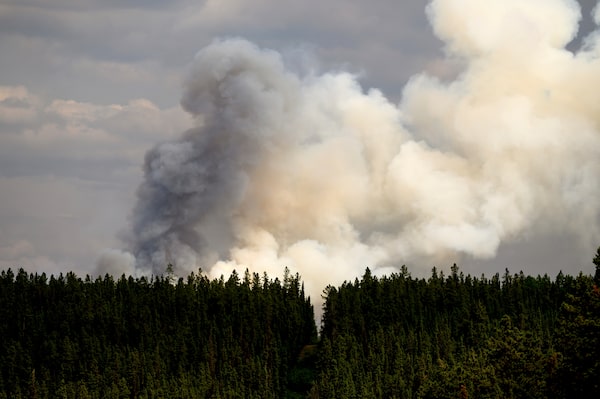
Smoke billows from the Donnie Creek wildfire burning north of Fort St. John, B.C., on July 2, 2023.Noah Berger/The Associated Press
Wildfire smoke is responsible for about the same number of premature deaths in Canada each year as traffic pollution, researchers estimate, though they say there is a long way to go before understanding what the long-term consequences could be on people’s health.
The only study to ever quantify such fatalities in Canada was released in July, 2020, and analyzed the health impacts of smoke from the 2013 to 2015 wildfire season and the 2017 to 2018 season. In the paper published in Science of the Total Environment, authors from Health Canada, Environment and Climate Change Canada, and the BC Centre for Disease Control (BCCDC) estimated that between 624 and 2,740 people would die each year from the short-term and chronic impacts of breathing in such levels of smoke. The resulting annual health care costs were calculated at anywhere from $4.7-billion to $20.8-billion.
EXPLAINER: How does wildfire smoke affect air quality and your health?
This summer, in which fires have already consumed more than three times the area burned than that in any one of the study’s years on average, is likely to result in an even greater number of premature deaths, according to lung specialist Christopher Carlsten. And that upward trend may continue as climate scientists anticipate an increase in wildfire frequency and severity in the future.
The danger was underlined earlier this month when a nine-year-old boy from 100 Mile House, B.C. died from an asthma attack his parents said was exacerbated by wildfire smoke. The BCCDC issued a public safety bulletin in response and said it’s investigating the boy’s death.
But while experts can predict some of the likely consequences of more regular wildfire smoke based on what they know of air pollution in general, they say they won’t understand its full impacts for several years down the road.
“It’s the biggest unknown,” said Dr. Carlsten, the head of the University of British Columbia’s respiratory medicine division.
His team at the Air Pollution Exposure Laboratory is now one of multiple research groups shifting their work from the impacts of traffic and industrial pollution to that of wildfire smoke. One question they’re interested in answering is how smoke differs from other air pollution.
A March, 2021 study of wildfires in Southern California, published in the Nature Communications journal, found the tiny particles released in smoke were 10 times more toxic than those in regular air pollution. The particles of concern are known as particulate matter 2.5 (PM2.5), meaning they are 2.5 microns in diameter or smaller. An average human hair, by comparison, is around 70 microns.
The danger of such microscopic particles is their ability to slip past the body’s defence systems and infiltrate a person’s airways and bloodstream, Dr. Carlsten said. When someone sucks in a breath of wildfire smoke-filled air, the sticky hair-lined inside of their nose does its best to cling onto as many particles as possible, but most of the small ones, the PM2.5, will sneak by and head deeper into the person’s airways.
Once the particles have made it to a person’s trachea, they will encounter specialized protector cells known as macrophages. The macrophages are patrollers intended to destroy any foreign material, but they weren’t designed to deal with such an onslaught of smoke particles, and the PM2.5 will overwhelm the cells, Dr. Carlsten said. From there, the smoke particles will be free to cling to the sides of a person’s airways and lungs and even make their way into the person’s bloodstream.
Widespread inflammation ensues, Dr. Carlsten said. This is particularly dangerous for people with respiratory diseases, heart or lung conditions, and cancer or diabetes. Elderly people, young children and pregnant people are also at a higher risk.
Taken together, Dr. Carlsten said, a large proportion of the population is especially vulnerable to wildfire smoke: “We know there’s a massive public-health problem, but it can be quantitatively overwhelming.”
And beyond determining the danger of wildfire smoke, there’s the challenge of protecting people from it. It’s possible to impose regulations on pollution sources such as industrial activities and traffic, but far more difficult to do so on fires.
“Wildfire smoke is a different beast,” said Carlyn Matz, a senior air quality evaluator at Health Canada and one of the authors of the study on premature deaths.
OPINION: Canada’s wildfire approach needs to shift from reactive to proactive
THE DECIBEL: The people most affected by wildfire smoke
Kerri Johannson, a pulmonologist and professor at the University of Calgary’s school of medicine, said lung specialists normally advise people to avoid breathing in anything but clean air, but that becomes unrealistic when wildfire smoke persists for weeks on end. There are steps individuals can take, such as staying indoors and masking when outside, but Dr. Johannson said the only long-term solution she sees is getting on top of wildfires.
“There are policy-level decisions about land management that need to be prioritized in our country, because every person living here is potentially at risk for all the consequences of this,” she said.
Dr. Johannson said it’s always a challenge to convince people to take action before they can see the true impacts of something, but that waiting another 10 or 20 years to see the cumulative effects of regularly breathing in wildfire smoke would be a mistake.
“We may not be seeing it immediately now, but the potential long-term consequences are substantial.”